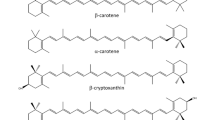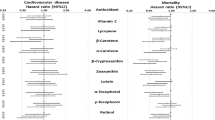Abstract
Background
Plasma carotenoids are considered a valid biological marker for fruit and vegetable dietary intake. Recent studies show that low carotenoid levels are associated with a high risk of inflammation, cancer, and cardiovascular disease.
Aim of the study
To determine whether low plasma carotenoids are associated with increased mortality among older adults.
Methods
Longitudinal study among 1,043 adults, 65 years and older, in the InCHIANTI study, a population-based cohort of adults living in the community in the Tuscany region, Italy.
Results
Mean total carotenoid concentration was 1.80 µmol/l. During eight years of follow-up, 310 (29.7%) of participants died. Eight-year survival was lower in the lowest compared with the highest tertile of total serum carotenoids (P < 0.0001 by Mantel-Haenszel chi-square). In a multivariate Cox proportional hazards model adjusted for age, education, smoking, body mass index, energy intake, and chronic diseases, adults in the highest tertile of plasma carotenoids at enrollment had lower mortality compared to those in the lowest tertile (Hazards Ratio obtained by considering carotenoids level as an ordinal variable 0.81, 95%; CI 0.65–0.99; P for trend = 0.046).
Conclusions
Low plasma carotenoids are an independent risk factor for mortality among older adults living in the community.


Similar content being viewed by others
References
Akbaraly TN, Favier A, Berr C (2008) Total plasma carotenoids and mortality in the elderly: results of the epidemiology of vascular ageing (EVA) study. Br J Nutr 29:1–7
Buijsse B, Feskens EJ, Schlettwein-Gsell D, Ferry M, Kok FJ, Kromhout D, de Groot LC (2005) Plasma carotene and α-tocopherol in relation to 10-y all-cause and cause-specific mortality in European elderly: the survey in Europe on nutrition and the elderly, a concerted action. Am J Clin Nutr 82:879–886
Comstock GW, Alberg AJ, Helzlsouer KJ (2004) Reported effects of long-term freezer storage on concentrations of retinol, β-carotene, and α-tocopherol in serum or plasma summarized. Clin Chem 39:1075–1078
Dietrich M, Block G, Norkus EP, Hudes M, Traber MG, Cross CE, Packer L (2003) Smoking and exposure to environmental tobacco smoke decrease some plasma antioxidants and increased γ-tocopherol in vivo after adjustment for dietary antioxidant intakes. Am J Clin Nutr 77:160–166
Dorgan JF, Boakye NA, Fears TR, Schleicher RL, Helsel W, Anderson C, Robinson J, Guin JD, Lessin S, Ratnasinghe LD, Tangrea JA (2004) Serum carotenoids and α-tocopherol and risk of nonmelanoma skin cancer. Cancer Epidemiol Biomarkers Prev 13:1276–1282
Ferrucci L, Bandinelli S, Benvenuti E, Di Iorio A, Macchi C, Harris TB, Guralnik JM (2000) Subsystems contributing to the decline in ability to walk: bridging the gap between epidemiology and geriatric practice in the InCHIANTI study. J Am Geriatr Soc 48:1618–1625
Ferrucci L, Corsi A, Lauretani F, Bandinelli S, Bartali B, Taub DD, Guralnik JM, Longo DL (2005) The origins of age-related proinflammatory state. Blood 105:2294–2299
Fletcher AE, Breeze E, Shetty PS (2003) Antioxidant vitamins and mortality in older persons: findings from the nutrition add-on study to the medical research council trial of assessment and management of older people in the community. Am J Clin Nutr 78:999–1010
Folstein MF, Folstein SE, McHugh PR (1975) “Mini-mental state” a practical method for grading the cognitive state of patients for the clinician. J Psychiatr Res 12:189–198
Food Nutrition Board (2000) Dietary reference intakes for vitamin C, vitamin E, selenium, and carotenoids. National Academy of Sciences, Washington, DC
Galan P, Viteri FE, Bertrais S, Czernichow S, Faure H, Arnaud J, Ruffieux D, Chenal S, Arnault N, Favier A, Roussel AM, Hercberg S (2005) Serum concentrations of β-carotene, vitamins C and E, zinc and selenium are influenced by sex, age, diet, smoking status, alcohol consumption and corpulence in a general French adult population. Eur J Clin Nutr 59:1181–1190
Genkinger JM, Platz EA, Hoffman SC, Comstock GW, Helzlsouer KJ (2004) Fruit, vegetable and antioxidant intake and all-cause, cancer, and cardiovascular disease mortality in a community-dwelling population in Washington County, Maryland. Am J Epidemiol 160:1223–1233
Gruber M, Chappell R, Millen A, LaRowe T, Moeller SM, Iannaccone A, Kritchevsky SB, Mares J (2004) Correlations of serum lutein + zeaxanthin: findings from the third national health and nutrition examination survey. J Nutr 134:2387–2394
Guralnik JM, Fried LP, Simonsick EM, Kasper D, Lafferty ME (1995) The women’s health and aging study: health and social characteristics of older women with disability. National Institute on Aging, Bethesda, NIH Publication No. 95-4009
He FJ, Nowson CA, MacGregor GA (2006) Fruit and vegetable consumption and stroke: meta-analysis of cohort studies. Lancet 367:320–326
Hu P, Reuben DB, Crimmins EM, Harris TB, Huang MH, Seeman TE (2004) The effects of serum β-carotene concentration and burden of inflammation on all-cause mortality risk in high-functioning older persons: MacArthur studies of successful aging. J Gerontol 8(59A):849–854
Ito Y, Kurata M, Suzuki K, Hamajima N, Hishida H, Aoki K (2006) Cardiovascular disease mortality and serum carotenoid levels: a Japanese population-based follow-up study. J Epidemiol 16:154–160
Ito Y, Wakai K, Suzuki K, Tamakoshi A, Seki N, Ando M, Nishino Y, Kondo T, Watanabe Y, Ozasa K, Ohno Y, JACC Study Group (2003) Serum carotenoids and mortality from lung cancer: a case-control study nested in the Japan collaborative cohort study. Cancer Sci 94:57–63
Joshipura KJ, Hu FB, Manson JE, Stampfer MJ, Rimm EB, Speizer FE, Colditz G, Ascherio A, Rosner B, Spiegelman D, Willett WC (2001) The effect of fruit and vegetable intake on risk for coronary heart disease. Ann Intern Med 134:1106–1114
Knekt P, Ritz J, Pereira MA, O’Reilly EJ, Augustsson K, Fraser GE, Goldbourt U, Heitmann BL, Hallmans G, Liu S, Pietinen P, Spiegelman D, Stevens J, Virtamo J, Willett WC, Rimm EB, Ascherio A (2004) Antioxidant vitamins and coronary heart disease risk: a pooled analysis of 9 cohorts. Am J Clin Nutr 80:1508–1520
Knoops KT, de Groot LC, Kromhout D, Perrin AE, Moreiras-Varela O, Menotti A, van Staveren WA (2004) Mediterranean diet, lifestyle factors, and 10-year mortality in elderly European men and women. JAMA 292:1433–1439
van Lettow M, Harries AD, Kumwenda JJ, Zijlstra EE, Clark TD, Taha TE, Semba RD (2004) Micronutrient malnutrition and wasting in adults with pulmonary tuberculosis with and without HIV co-infection in Malawi. BMC Infect Dis 4:61
Lopez-Garcia E, Schulze MB, Fung TT, Meigs JB, Rifai N, Manson JE, Hu FB (2004) Major dietary patterns are related to plasma concentrations of markers of inflammation and endothelial dysfunction. Am J Clin Nutr 80:1029–1035
Manach C, Mazur A, Scalbert A (2005) Polyphenols and prevention of cardiovascular diseases. Curr Opin Lipidol 16:77–84
McEligot AJ, Yang S, Meyskens FL (2005) Redox regulation by intrinsic species and extrinsic nutrients in normal and cancer cells. Annu Rev Nutr 25:261–295
Michelon E, Blaum C, Semba RD, Xue QL, Ricks MO, Fried LP (2006) Vitamin and carotenoid status in older women: associations with the frailty syndrome. J Gerontol A Biol Sci Med Sci 61:600–607
Pisani P, Faggiano F, Krogh V, Palli D, Vineis P, Berrino F (1997) Relative validity and reproducibility of a food frequency dietary questionnaire for use in the Italian EPIC centres. Int J Epidemiol 26(Suppl 1):S152–S160
Polidori MC, Stahl W, Eichler O, Niestroj I, Sies H (2001) Profiles of antioxidants in human plasma. Free Radic Biol Med 30:456–462
Ray AL, Semba RD, Walston J (2006) Low serum selenium and total carotenoids predict mortality among older women living in the community: the women’s health and aging studies. J Nutr 136:172–176
Riboli E, Norat T (2003) Epidemiologic evidence of the protective effect or fruit and vegetables on cancer risk. Am J Clin Nutr 78(suppl):559S–569S
Trichopoulou A, Costacou T, Bamia C, Trichopoulos D (2003) Adherence to a Mediterranean diet and survival in a Greek population. N Engl J Med 348:2599–2608
Waart FG, Schouten EG, Stalenhoef AFH, Kok FJ (2001) Serum carotenoids, α-tocopherol and mortality risk in a prospective study among dutch elderly. Int J Epidemiol 30:136–143
Walston J, Xue Q, Semba RD, Ferrucci L, Cappola AR, Ricks M, Guralnik J, Fried LP (2006) Serum antioxidants, inflammation, and total mortality in older women. Am J Epidemiol 163:18–26
Acknowledgments
This work was supported by National Institute on Aging Contracts N01-AG-916413, N01-AG-821336, N01-AG-5–0002, and NIA Grant R01 AG027012. This research was supported in part by the Intramural Research Program, National Institute on Aging, NIH.
Author information
Authors and Affiliations
Corresponding author
Rights and permissions
About this article
Cite this article
Lauretani, F., Semba, R.D., Dayhoff-Brannigan, M. et al. Low total plasma carotenoids are independent predictors of mortality among older persons. Eur J Nutr 47, 335–340 (2008). https://doi.org/10.1007/s00394-008-0732-9
Received:
Accepted:
Published:
Issue Date:
DOI: https://doi.org/10.1007/s00394-008-0732-9




